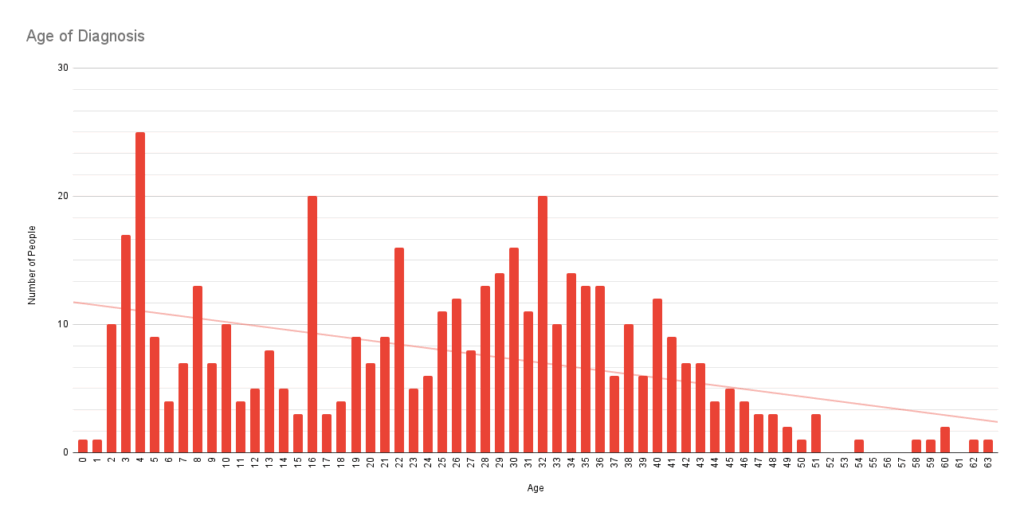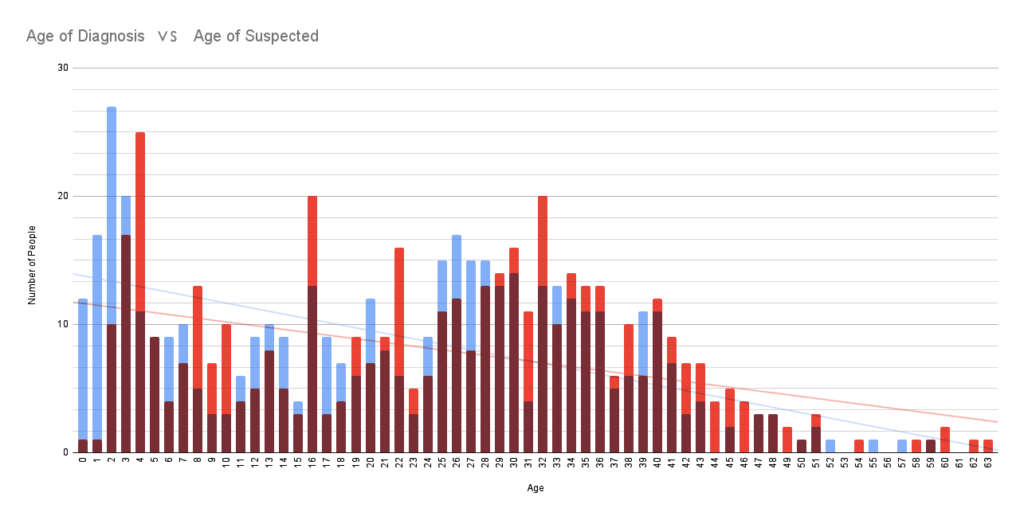I am autistic and was diagnosed at the age of 29. Considering many autistic people like myself are missed in childhood and suffer from a lot of mental health issues, I wanted to know how prevalent late diagnosis is and how late a late diagnosis occurs.
Disclaimer: this was not a clinical study and all data was self-reported.
Objective
To assess the effects of masking in autistic adults based on the age of their late diagnosis.
Search methods
The survey was published on my website in a variety of private Facebook groups and shared publicly on Facebook and TikTok starting on March 23rd. Additionally, the author paid for a sponsored Facebook post targeting autistic adults and caregivers of autistic children that ran for 20 days from March 24, 2022, to April 13, 2022.
- Âûtistic News Feed
- Autistic Voices
- Autistics Worldwide (with admin permission)
- Just 1 Voice
- Mums on the Spectrum (with admin permission)
- One Bad Autistic
- sounds like you hate autistic people but ok
- this is autistic culture
Selection criteria
Participants included people of all ages with either a clinical Autism Spectrum Disorder diagnosis or identified as autistic as well as caregivers on behalf of a child with either a clinical ASD diagnosis or identified as autistic.
Data collection and analysis
Survey responses were collected anonymously through a Google Form. The survey had 2 questions:
- How old were you when you received the diagnosis OR when you decided to self-diagnose? If answering for a child, how old were they when they received their diagnosis?
- How old were you when you first suspected you were autistic and/or decided to pursue a diagnosis? If answering for a child, how old were they when you started suspecting they might be autistic?
The answer options for both questions was a select field with ages ranging from 0 to 80. The answers to question one were categorized as “Age of Diagnosis” while the answers to question 2 were categorized as “Age of Suspicion”.
Main results
The survey was closed on April 18th after having collected a total of 452 responses.
| Total Responses | 452 |
| Average Age of Suspicion | 21.2 |
| Median Age of Suspicion | 23 |
| Mode Age of Suspicion | 2 |
| Average Age of Diagnosis | 24.5 |
| Median Age of Diagnosis | 26 |
| Mode Age of Diagnosis | 4 |
All 452 responses were categorized into two groups based on their age at the time they suspected vs age of diagnosis.
| Life Stage | Suspicion Total | Suspicion Total % | Diagnosis Total | Diagnosis Total % |
|---|---|---|---|---|
| Child | 186 | 41.15% | 152 | 33.63% |
| Adult | 266 | 58.85% | 300 | 66.37% |
The following chart further looks at the 186 responses that suspected when they were a child and the 152 responses that were diagnosed as a child.
| Age Group | Suspicion | Suspicion % | Diagnosis | Diagnosis % |
|---|---|---|---|---|
| Baby | 29 | 15.59% | 2 | 1.32% |
| Toddler | 47 | 25.27% | 27 | 17.76% |
| Preschool | 11 | 5.91% | 25 | 16.45% |
| Child | 54 | 29.03% | 59 | 38.82% |
| Teen | 45 | 24.19% | 39 | 25.66% |
The following chart further looks at the 266 responses that suspected when they were an adult and the 300 responses that were diagnosed as an adult.
| Age Group | Suspicion | Suspicion % | Diagnosis | Diagnosis % |
|---|---|---|---|---|
| Young Adult | 66 | 24.81% | 67 | 22.33% |
| Adult | 193 | 72.56% | 222 | 74% |
| Older Adult | 7 | 2.63% | 11 | 3.67% |
| Senior | 0 | 0% | 0 | 0% |
After normalizing the data, this first chart shows the total number of people who suspected they were autistic at each age. The charts end at 63 since that was the age of the oldest participant.

This second chart shows the total number of people who were diagnosed as autistic at each age.

This third chart overlays the two charts, comparing their results on the same scale.

Author’s conclusions
This survey is congruent with metrics measuring the most common age for childhood diagnosis for autism spectrum disorder (age 4). In figures 5 and 6, we can see that both the age of suspicion and age of diagnosis follow a bimodal distribution with the first peak in early childhood around the preschool age and the second peak in adulthood.
In figure 7, we can see the first peak for both are closer together, meaning the time between suspicion and diagnosis happens rather quickly. The second peak for age of suspicion occurs around the mid-20’s while the second peak for age of diagnosis is closer to the late 20’s/early 30’s, meaning it takes a longer time to diagnose. This could be due to the lack of information around adult autism presentation and identification.
Additionally, the fact that there is a peak in adulthood shows that undiagnosed autistic children grow up and start to suspect they’re autistic after about 25 years. My hypothesis is that this is when the stress of living as an autistic person masking as a neurotypical person is becoming too much, contributing to a poorer mental health than their early diagnosed counterparts. We can see that the autistic person is starting to suspect and recognize that something is going on and that they begin to seek medical attention around this age.
Author
Tessa Watkins, B.S., Autistic
Acknowledgements
We thank Dr. John D. Watkins for providing advice and logistical support for the analysis of the survey. We wish to also thank the Facebook administrators and TikTok creators that assisted with the searches.
References
- Office of Autism Research Coordination National Institutes of Health, “Report to Congress in Activities Related to Autism Spectrum Disorder and Other Developmental Disabilities under The Autism Collaboration, Accountability, Research, Education, and Support Act (Autism CARES Act) of 2014 (FY 2014 – FY 2018)” (Mar. 2019). Office of the Secretary Department of Health and Human Services.
- David S. Mandell, Maytali M. Novak, and Cynthia D. Zubritsky, “Factors Associated With Age of Diagnosis Among Children With Autism Spectrum Disorders” (Apr. 29, 2010). Pediatrics.
- “Key Findings: CDC Releases First Estimates of the Number of Adults Living with Autism Spectrum Disorder in the United States” (Apr. 27, 2020) Centers for Disease Control and Prevention.
- “Data & Statistics on Autism Spectrum Disorder” (Dec. 2, 2021) Centers for Disease Control and Prevention.
- Mira Miller, “Study: Autism Diagnosis Later in Life Linked to Worse Mental Health” (Oct. 11, 2021). Verywell Health.
- Steven D. Stagg and Hannah Belcher, “Living with autism without knowing: receiving a diagnosis in later life” (Nov. 6, 2019). Health Psychology and Behavioral Medicine.
- Donald McCarthy and Undark, “The cost of a delayed autism diagnosis” (Dec. 3, 2019). Spectrum.
- Cheryl Platzman Weinstock, “The deep emotional ties between depression and autism” (Jul. 31, 2019). Spectrum.
- Featured photo by Sydney Sims on Unsplash.
